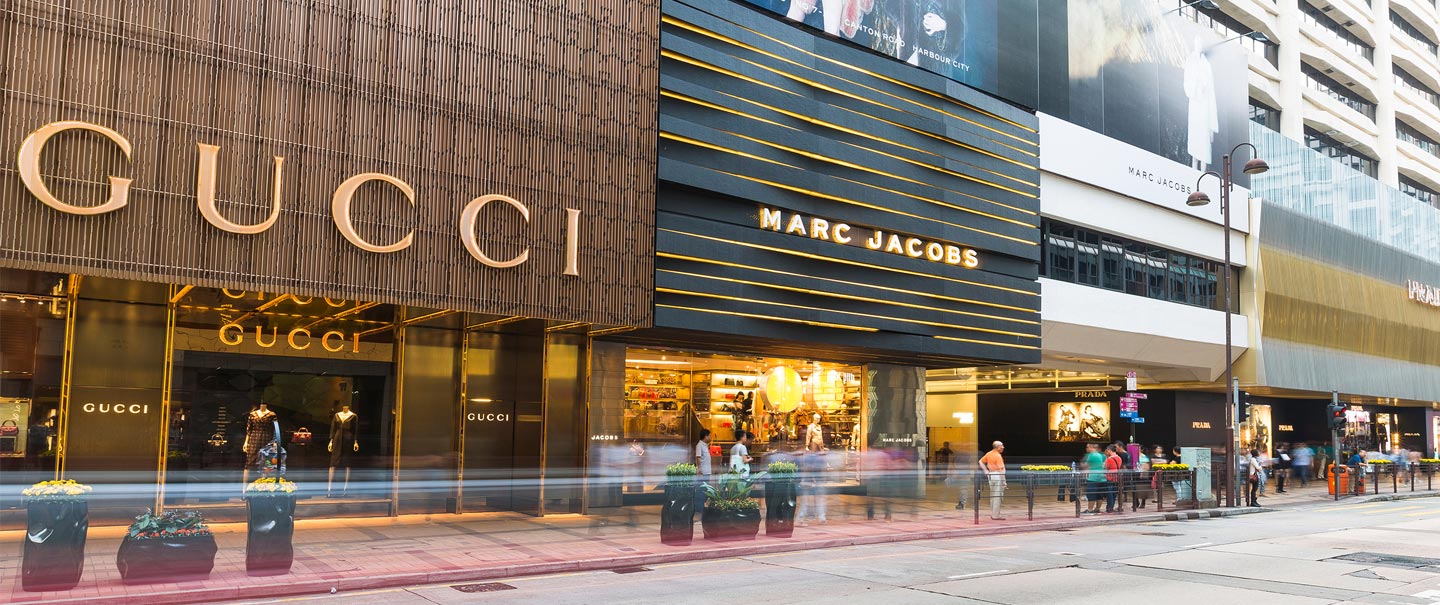Tax haven, breathtaking skyline, luxury boutiques and hi-tech. Welcome to Hong Kong
In recent years the “Pearl of the Orient” has experienced an economic slowdown, especially with regards to the luxury retail sector – one of its GDP main driving forces – that has plunged to 17-years low by the end of 2016.
Is the “shopper’s paradise” lost forever? I don’t think so.

Several luxury stores in Hong Kong.
WHAT IS HAPPENING?
Let’s first focus on why this is happening. What are the main causes of this ongoing slump?
Chinese Yuan Renminbi depreciation
Due to its geography, Hong Kong’s retail sector largely relies on tourist spending (and their purchasing power). In particular, Chinese mainlanders account for more than 70% of the total tourists, but, since Beijing’s currency devaluation policy in 2015 and the consequential RMB’s loss of purchasing power against the Hong Kong dollar, it seems they now prefer to shop in the more affordable south-east Asia.
Chinese middle-upper class lifestyle
The raising Chinese middle-upper class consumers are rapidly evolving, at the same (or even faster) pace of Chinese economy: they are shifting to new consumption patterns, becoming keener to enjoy a healthy and sporty lifestyle. They prefer to spend their money in travels, sport activities and events, and engaging EXPERIENCES, rather than mere luxury goods. Among the driving forces of this shift of habits, Chinese women play a major role: they have a way higher purchasing power than 10 years ago, and they’re focusing their spending habits more on physical activities and healthy products (such as fitness, outdoor events, sports and related goods, healthy restaurants, food supplements…etc) rather than just buying jewelry or the latest Prada bag. In other terms, enjoying life and having a fit and healthy body is becoming trendier than having shiny accessories.
Multichannel retailing
In the past few years digitalization has completely revolutionized Asian markets, and it will keep doing so for a while. The eCommerce boom, driven by hi tech giants such as Alibaba, Amazon and more recently Tencent, has pushed most companies and brands to start selling online and invest a lot of capital in it. Accordingly, the high competition and the savings opportunities deriving from selling online (less inventory management costs, no rent or personnel costs…etc.) has forced many brands to rebate online prices and run digital campaigns and promotions. The result? Digital stores are becoming the main competitors of their own brand’s physical stores.

Women ready to enjoy a run organized by a running club in Hong Kong.
TRENDS & OPPORTUNITIES
How are companies coping with these challenges?
Not only luxury
The shrinking luxury retail market is having a major consequence: it’s driving the rents down, especially in prime retail locations. Let’s take Russel Street in Causeway bay as an example. Used to be ranked as one of the most expensive shopping strips in the world, in the last two years it has seen its rents dropping significantly: spaces that could be rented for HKD 2,500 per sq ft just two years ago, can be leased today for just HKD 1,000 per sq ft. This trend has opened up opportunities for middle/mass markets brands and shops to find themselves a spot in primary locations. In particular, Sport goods retailers are taking advantage of this, leveraging this new tendency. Surprisingly enough, in order to compete with these mass market firms, even luxury brands are entering the sport apparel business, by launching their own sneakers and sporting accessories.
“Shoppertainment”: the rise of entertaining shopping hubs
The lower rents, together with the shift of consumer habits towards experiencing recreational activities, are creating another exciting trend. Since retailers have access to more space for a lower price, they are allowed to use it more creatively to entertain and engage their shoppers. This practice, known as “Shoppertainment”, consists in incorporating in-store shopping experiences (often involving hi-tech) to attract customers and build brand awareness. The front runner of this trend is again the activewear and sport apparel sector. The Causeway Bay Adidas store, for example, added a virtual reality fitting room giving the customers the chance to try new products in training run simulations, using also a temperature control system to simulate winter weather. In addition, more and more companies running shopping malls, such as Swire Properties, have significantly increased their food and beverage footprint as well as improved their cinema complexes with cutting edge technology. In fact, these shopping centers are evolving into entertainment hubs, revolutionizing shopping as we know it today.
Omnichannelling
Last but not least, how to properly ride the wave of retail digitalization? The answer is devising an intelligent omnichannel strategy.
What is it?
On the retailer’s side, it means being able to properly manage physical resources and operations (shops, warehouses, products, orders…etc.) with digital activities (web stores, social media, digital campaigns and promotions, ERP and CRM software…etc.) as a single entity, in order to create a unique and profitable sales process. In other words, physical and digital are in symbiosis, and play as complements rather than competitors.
On the consumer’s side, the result is a completely new shopping experience, where the benefits of both dimensions – digital and physical – can be enjoyed.

In-store VR experience.
CONCLUSION
As you should have realized, the “shopper’s paradise” is everything but lost; it’s just rapidly evolving, along with its customers’ lifestyle and expectations. If you’ll be able to offer an engaging all-around shopping EXPERIENCE, by exploiting technology, integrating online and offline channels, and providing entertaining subsidiary activities, you are setting up all the preconditions to let your Hong Kong retail business take off.
 BRICKS AND CLICKS WITH TLG
BRICKS AND CLICKS WITH TLG
Wondering what’s the ideal way to integrate online and offline? TLG’s software LogiCommerce offers a fully customized solution to set up a flexible omnichannel retail network in Hong Kong, turning eCommerce platforms and brick & mortar stores into powerful allies.
For more info, visit: http://www.tlgcommerce.com.hk/

